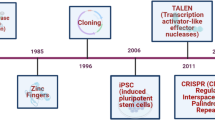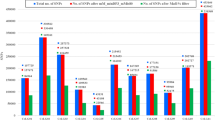Abstract
POU1F1 is an essential factor that regulates the development and reproduction of animal. The objective of the current research was to screen for polymorphism, expression of POU1F1 and their association with carcass quality traits. A total of 126 Erlang mountainous chickens from two strains (SD02 and SD03) were employed for testing. Seventeen single nucleotide polymorphisms (SNPs) were detected, but only two SNPs (g.96217999 T > C and g.96219442 C > T) were associated with carcass quality traits. In SD03 chicken, g.96217999 T > C genotypes were significantly associated with body weight (BW), carcass weight (CW), eviscerated weight (EW), and semi-eviscerated weight (SEW; P < 0.05), and was highly significantly associated with breast muscle weight (BMW) and abdominal fat weight (AW; P < 0.01). g.96219442 C > T was significantly associated with BW, EW, SEW (P < 0.05). However, these two SNPs were not significantly associated with any carcass traits in SD02 chicken. Diplotypes showed that in SD03 chicken, the haplotype [C: C] was the most favorable haplotype because it was associated with higher BW, CW, SEW, EW, BMW, and AW (P < 0.05). On the contrary, haplotype [T: T] was associated with lower carcass quality traits (P < 0.01). In addition, qRT-PCR revealed that at 13 weeks, the POU1F1 mRNA expression was significantly higher in breast muscle of cock compared to that of hens (P < 0.05), whereas there was no significant correlation between POU1F1 expression and carcass traits. These results suggested that POU1F1 could be a potential candidate gene for carcass traits in chicken.
Similar content being viewed by others
References
Chung HO, Kato T, Tomizawa K, Kato Y (1998) Molecular cloning of pit-1 cDNA from porcine anterior pituitary and its involvement in pituitary stimulation by growth hormone-releasing factor. Exp Clin Endocrinol Diabetes 106:203–210
Ingraham HA, Albert VR, Chen RP et al (1990) A family of POU-domain and Pit-1 tissue-specific transcription factors in pituitary and neuroendocrine development. Annu Rev Physiol 52:773–791
Mangalam HJ, Albert VR, Ingraham HA et al (1989) A pituitary POU domain protein, Pit-1, activates both growth hormone and prolactin promoters transcriptionally. Gene Dev 3:946
Nelson C, Albert VR, Elsholtz HP et al (1988) Activation of cell-specific expression of rat growth hormone and prolactin genes by a common transcription factor. Science 239:1400–1405
Steinfelder HJ, Hauser BE, Nakayama Y, Radovick S et al (1991) Thyrotropin-releasing hormone regulation of human TSHβ expression: role of a pituitary-specific transcription factor (Pit-1/GHF-1) and potential interaction with a thyroid hormone-inhibitory element. Proc Nat Acad Sci USA 88:3130–3134
Pfffle R, DiMattia G, Parks J et al (1992) Mutation of the POU-specific domain of Pit-1 and hypopituitarism without pituitary hypoplasia. Science 257:1118–1121
Tatsumi K, Miyai K, Notomi T et al (1992) Cretinism with combined hormone deficiency caused by a mutation in the PIT1 gene. Nat Genet 1:56–58
Sun Y, Zhang F, Gao J et al (2006) Positive association between POU1F1 and mental retardation in young females in the Chinese Han population. Hum Mol Genet 15:1237
Yu T, Tuggle C, Schmitz C et al (1995) Association of PIT1 polymorphisms with growth and carcass traits in pigs. J Anim Sci 73:1282–1288
Yu TP, Rothschild MF, Tuggle CK (1993) Rapid communication: a MspI restriction fragment length polymorphism at the swine POU1F1 locus. J Anim Sci 71:2275
Song C, Gao B, Teng Y et al (2005) MspI polymorphisms in the 3rd intron of the swine POU1F1 gene and their associations with growth performance. J Appl Genet 46:285–289
Song CY, Gao B, Teng SH et al (2007) Polymorphisms in intron 1 of the porcine POU1F1 gene. J Appl Genet 48:371–374
Fang H, Zheng YM, Li HB et al (2009) Relationship of single nucleotide polymorphism of intrion 1 in porcine POU1F1 and the growth trait. Sci Agric Sin 42:283–289
Song CY, Zhao Q, Gao B et al (2011) Polymorphism analysis of POU1F1 promoter region and its association with growth traits. Sci Agric Sin 44:5067–5072
Hu Z (2008) The advanced progress of POU1F1 gene in bovine and caprine. China Cattle Sci 34:56–60
Jia XJ, Qin J, Li QL et al (2011) Research progress of single nucleotide polymorphism of bovine POU1F1 gene and the relationship with milk production traits. China Anim Hus Vet Med 38:138–142
Jia XJ, Wang CF, Yang GW, Huang JM et al (2011) Polymorphism of POU1F1 gene and PRL gene and their combined effects on milk performance traits in Chinese Holstein cattle. Hereditas (Beijing) 33:1359–1365
Lin JP, He SG, Bai J et al (2009) Correlations between POU1F1 polymorphism and milk yield in Xinjiang brown breed and Chinese Holstein. China Cattle Sci 35:1–4
Zhang C, Liu B, Chen H et al (2009) Associations of a Hinf I PCR-RFLP of POU1F1 gene with growth traits in Qinchuan cattle. Anim Biotech 20:71–74
Niu ZG, Shi HC, Liu MJ et al (2011) Polymorphism of POU1F1 Gene and Fitting of Early Growth Curve in Xinjiang Brown Cattle. Acta Agriculturae Boreali-Occidentalis Sinica 20(11):1–5
Zhao JW, Wu HG, Sun GQ et al (2010) Association study of POU1F1–exon 6 polymorphisms with growth traits in cattle. Heilong Jiang Anim Sci Vet Med 12:4–6
Mura MC, Daga C, Paludo M et al (2012) Analysis of polymorphism within POU1F1 gene in relation to milk production traits in dairy Sarda sheep breed. Mol Biol Rep 39(6):6975–6979
Zhang ZR, Liu YP, Yao YG et al (2009) Identification and association of the single nucleotide polymorphisms in calpain3 (CAPN3) gene with carcass traits in chickens. BMC Genet 10:10
Livak KJ, Schmittgen TD (2001) Analysis of relative gene expression data using real-time quantitative PCR and the 2-∆∆CT method. Methods 25:402–408
Chung H, Kato T, Tomizawa K et al (1998) Molecular cloning of pit-1 cDNA from porcine anterior pituitary and its involvement in pituitary stimulation by growth hormone-releasing factor. Exp Clin Endocrinol Diab 106:203–210
Cohen LE, Wondisford FE, Radovick S (1996) Role of Pit-1 in the gene expression of growth hormone, prolactin, and thyrotropin. Endocrinol Metab Clin North Am 25:523–540
Staneková K, Vaíek D, Pekoviová D et al (1999) Effect of genetic variability of the porcine pituitary-specific transcription factor (PIT-1) on carcas traits in pigs. Anim Genet 30:313–315
Yu T, Sun H, Wahls S et al (2001) Cloning of the full length pig PIT1 (POU1F1) CDNA and a novel alternative PIT1 transcript, and functional studies of their encoded proteins. Anim Biotech 12:1
Renaville R, Gengler N, Vrech E et al (1997) Pit-1 gene polymorphism, milk yield, and conformation traits for Italian Holstein-Friesian bulls. J Dairy Sci 80:3431–3438
Xue K, Chen H, Wang S et al (2006) Effect of genetic variations of the POU1F1 gene on growth traits of Nanyang cattle. Acta Genetica Sinica 33(10):901–907
Zwierzchowski L, Krzyzewski J, Strzalkowska N et al (2002) Effects of polymorphism of growth hormone (GH), Pit-1, and leptin (LEP) genes, cow’s age, lactation stage and somatic cell count on milk yield and composition of Polish Black-and-White cows. Anim Sci Papers Rep 20(2):213–227
Brunsch C, Sternstein I, Reinecke P et al (2002) Analysis of associations of PIT1 genotypes with growth, meat quality and carcass composition traits in pigs. J Appl Genet 43:85–92
Moody D, Pomp D, Newman S et al (1996) Characterization of DNA polymorphisms in three populations of Hereford cattle and their associations with growth and maternal EPD in line 1 Herefords. J Anim Sci 74:1784
Nie Q, Fang M, Xie L et al (2008) The PIT1 gene polymorphisms were associated with chicken growth traits. BMC Genet 9(20):1–5
Qiu FF, Nie QH, Jin WG et al (2006) Association of a 57 bp Indel in chicken PIT-1 gene with growth and carcass traits. Acta Agri Uni Jiangxi Ensis (China) 28:284–288
Luo WX, Wang XQ et al (2011) Relationship between polymorphism of POU1F1 gene and slaughter traits of goat. Chinese J Anim Sci 47(9):5–9
Capon F, Allen MH, Ameen M et al (2004) A synonymous SNP of the corneodesmosin gene leads to increased mRNA stability and demonstrates association with psoriasis across diverse ethnic groups. Hum Mol Genet 13:2361–2368
Grindflek E, Hoen N, Sundvold H et al (2004) Investigation of a peroxisome proliferator-activated receptor gamma haplotype effect on meat quality and carcass traits in pigs. Anim Genet 35:238–241
Stephens JC, Schneider JA, Tanguay DA et al (2001) Haplotype variation and linkage disequilibrium in 313 human genes. Science 293:489–493
Fang H (2006) Studies on the relationship between polymorphism of porcine POU1F1 gene and the mRNA express of interrelated gene. Chinese Academy of Agriculture Sciences, Beijing
Liu L (2008) Studies on the polymorphism of sixth exon of POU1F1 gene and the expression of mRNA in Xinjiang brown cattle. Xinjiang Agricultural University
Acknowledgments
The authors gratefully acknowledge Yao Zhang for help in managing the birds and collecting the data. This work was financially supported by the Chinese national key technologies R & D programme (Grant no: 2008BADB2B01), the Science Fund for Young Scholars in Sichuan Province (Grant no: ZQ 026-017), the Research Fund for Doctoral Program of Higher Education of China (Grant no: 20105103120006), the Scientific Research Fund of Sichuan Provincial Education Department (Grant no: 10ZB033).
Author information
Authors and Affiliations
Corresponding author
Additional information
Heng-Yong Xu and Yan Wang contributed equally to this work.
Rights and permissions
About this article
Cite this article
Xu, HY., Wang, Y., Liu, YP. et al. Polymorphisms and expression of the chicken POU1F1 gene associated with carcass traits. Mol Biol Rep 39, 8363–8371 (2012). https://doi.org/10.1007/s11033-012-1686-9
Received:
Accepted:
Published:
Issue Date:
DOI: https://doi.org/10.1007/s11033-012-1686-9




